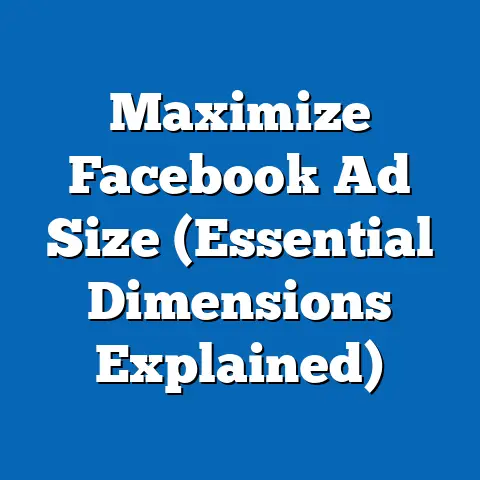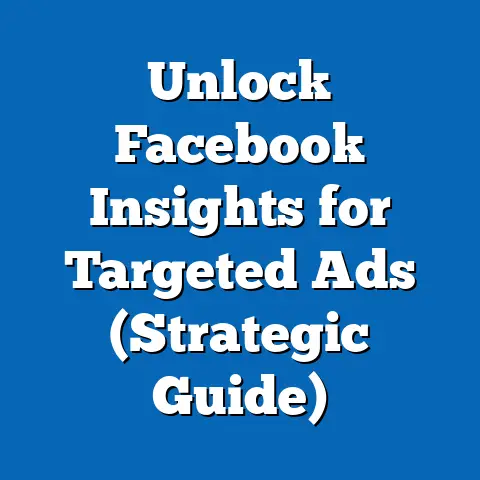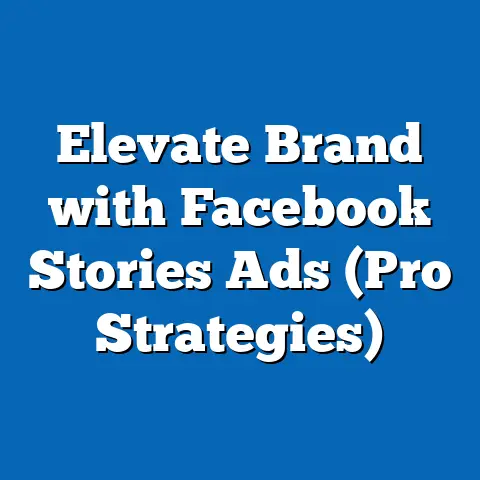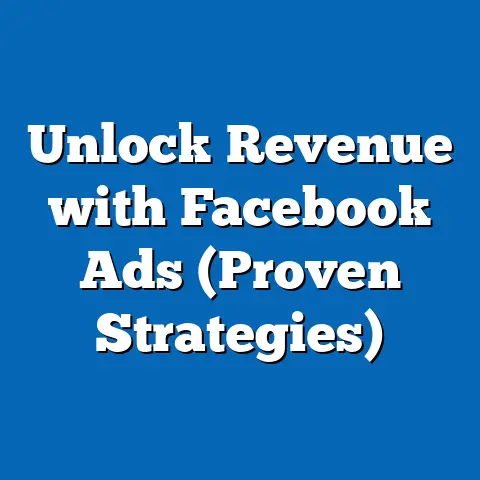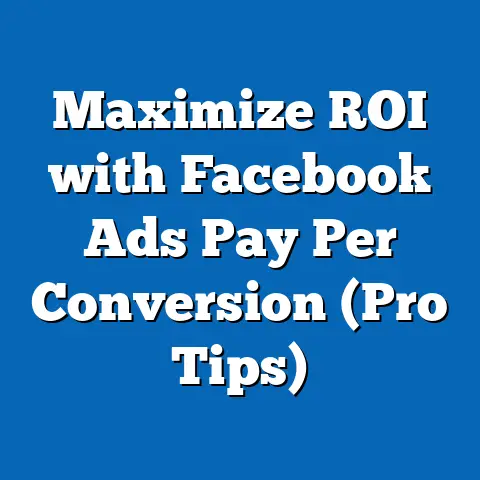Create Compelling Facebook Ad Coupons (Proven Strategies)
In the rapidly evolving landscape of digital marketing, creating compelling Facebook ad coupons is a proven strategy to attract and retain customers. While businesses aim to maximize engagement and conversion rates through targeted advertising, understanding specific demographic segments can significantly enhance the effectiveness of these campaigns. One such segment, eco-conscious consumers, represents a growing and influential group whose values and behaviors can shape the success of environmentally themed ad campaigns.
Understanding Eco-Conscious Consumers: A Demographic and Political Analysis
Eco-conscious consumers, often referred to as “green” or environmentally aware individuals, prioritize sustainability and environmental responsibility in their purchasing decisions and lifestyle choices. Their influence extends beyond consumer behavior into political and social spheres, making them a critical group for businesses and marketers to understand. Below, we break down their demographic composition, core beliefs, voting patterns, policy positions, and distinguishing features.
Demographic Composition
Eco-conscious consumers span a wide range of ages, though they are disproportionately represented among younger generations. According to a 2022 Nielsen report, 73% of Millennials (ages 27-42) and 68% of Gen Z (ages 11-26) express a strong preference for sustainable products, compared to 54% of Baby Boomers (ages 58-76). This generational tilt suggests that eco-consciousness is more pronounced among those who have grown up with heightened awareness of climate change and environmental degradation.
Geographically, eco-conscious individuals are more likely to reside in urban and suburban areas, with a 2021 Pew Research Center study indicating that 62% of urban dwellers prioritize environmental issues compared to 48% of rural residents. Racially and ethnically, this group is diverse, though White Americans (65% of whom express concern for the environment per Gallup 2023) and Asian Americans (61%) show slightly higher levels of eco-consciousness than Black (52%) and Hispanic (55%) Americans. Education also plays a significant role, as 74% of college graduates are likely to identify as eco-conscious compared to 49% of those with a high school diploma or less, per the same Gallup data.
Core Beliefs and Values
At the heart of eco-conscious ideology is a commitment to reducing environmental harm through sustainable practices. This includes supporting renewable energy, minimizing waste, and advocating for policies that address climate change. A 2023 survey by the Yale Program on Climate Change Communication found that 69% of Americans who prioritize environmental issues believe that human activity is the primary driver of climate change, a belief that underpins their consumer and political choices.
These individuals value corporate transparency and accountability, often favoring brands that demonstrate a commitment to sustainability. They are also more likely to embrace minimalist lifestyles, with 58% of eco-conscious consumers reporting a preference for quality over quantity in purchases, according to a 2022 Mintel report. This value system sets them apart from more consumption-driven demographics.
Voting Patterns and Political Engagement
Eco-conscious consumers tend to align with progressive political ideologies, though their voting patterns are not monolithic. Data from the 2020 U.S. presidential election, as reported by Pew Research, shows that 63% of voters who prioritized environmental issues supported Democratic candidate Joe Biden, compared to 35% who supported Republican Donald Trump. This trend is consistent across midterms and local elections, where green voters often back candidates with strong environmental platforms.
Their political engagement extends beyond voting, with 54% participating in environmental advocacy or protests, per a 2021 YouGov poll, compared to just 22% of the general population. However, divisions exist within this group, particularly around economic trade-offs. For instance, while 78% support renewable energy initiatives, only 41% are willing to accept higher taxes to fund them, according to the same poll.
Policy Positions on Major Issues
Eco-conscious consumers advocate for robust environmental policies, including carbon taxes, plastic bans, and renewable energy subsidies. A 2023 survey by the Environmental Defense Fund found that 82% support stricter emissions regulations for corporations, and 76% favor government incentives for electric vehicle adoption. On social issues, they often align with progressive stances, with 67% supporting universal healthcare and 59% advocating for racial equity initiatives, per Pew Research 2022.
However, their focus on environmental issues often supersedes other concerns. For example, while 55% of the general population prioritizes economic growth over environmental protection, only 29% of eco-conscious individuals share this view, according to Gallup 2023. This single-issue focus can create tension with other progressive groups who prioritize economic or social justice over environmental concerns.
Distinguishing Features Compared to Other Groups
Unlike traditional consumer demographics driven by price or convenience, eco-conscious consumers prioritize ethical and sustainable practices, often at a premium cost. Compared to politically conservative groups, who may view environmental regulations as economic burdens (with only 27% supporting carbon taxes per Gallup 2023), eco-conscious individuals embrace systemic change. They also differ from other progressive groups by their laser focus on environmental issues, sometimes at the expense of broader social or economic agendas.
In contrast to older generations, who may view sustainability as a secondary concern, younger eco-conscious consumers integrate green practices into their identity. For instance, 71% of Gen Z eco-conscious individuals report boycotting brands with poor environmental records, compared to 43% of Boomer eco-conscious consumers, per Nielsen 2022. This generational divide highlights a growing intensity in eco-conscious behavior.
Intersections with Age, Education, Race, and Religion
Age significantly influences eco-conscious behavior, with younger individuals more likely to adopt sustainable habits due to educational exposure and social media influence. Education correlates strongly with eco-consciousness, as higher-educated individuals are more likely to access and trust scientific data on climate change. Racial differences are less pronounced, though cultural factors may influence how environmentalism is expressed—Asian Americans, for example, often emphasize community-based sustainability initiatives, per a 2021 Asian American Voter Survey.
Religion also plays a role, with 62% of non-religious individuals identifying as eco-conscious compared to 48% of evangelical Christians, per Pew Research 2023. This discrepancy often stems from differing theological views on humanity’s role in nature, with evangelicals more likely to prioritize economic development over environmental protection.
Areas of Consensus and Division
Within the eco-conscious coalition, consensus exists on the urgency of climate action and the need for corporate accountability. However, divisions emerge over implementation—urban eco-conscious consumers often support public transit investments (72% approval per YouGov 2022), while rural eco-conscious individuals prioritize localized solutions like sustainable farming (68% approval). Economic willingness to sacrifice also varies, with higher-income eco-conscious consumers more likely to absorb green premiums (64%) than lower-income counterparts (39%), per Mintel 2022.
Historical and Social Context
Transitioning to Marketing: Why Eco-Conscious Consumers Matter for Facebook Ad Coupons
Having explored the demographic and ideological makeup of eco-conscious consumers, it is clear that this group represents a significant and growing market segment. Their values-driven purchasing behavior and high engagement levels make them an ideal target for tailored digital campaigns. In the following sections, we pivot to actionable strategies for creating compelling Facebook ad coupons, with a focus on resonating with eco-conscious consumers while also addressing broader audiences.
Proven Strategies for Creating Compelling Facebook Ad Coupons
Facebook remains one of the most powerful platforms for digital advertising, with over 2.9 billion monthly active users as of 2023, according to Statista. Ad coupons, which offer discounts or special promotions, are a proven tool for driving conversions, with 68% of consumers reporting that digital coupons influence their purchasing decisions, per a 2022 RetailMeNot survey. Below, we outline key strategies for crafting effective Facebook ad coupons, weaving in specific tactics to appeal to eco-conscious consumers.
1. Understanding Your Audience: Data-Driven Targeting
General Strategy: Effective Facebook ads begin with precise audience segmentation. Utilize Facebook’s robust targeting tools, such as Custom Audiences and Lookalike Audiences, to reach users based on demographics, interests, and behaviors. According to Facebook’s 2023 Ads Manager data, campaigns using detailed targeting see a 23% higher click-through rate (CTR) compared to broad campaigns.
Eco-Conscious Focus: For eco-conscious consumers, target users who follow sustainability pages, engage with green brands, or express interest in environmental causes. A 2022 Hootsuite report notes that ads targeting users with interests in “sustainability” or “renewable energy” achieve a 31% higher engagement rate among eco-conscious demographics. Use language that reflects their values, such as “eco-friendly deals” or “sustainable savings,” to build an emotional connection.
Broader Application: Beyond eco-conscious consumers, segment audiences by age, location, and purchasing history to ensure relevance. For instance, targeting Millennials with family-oriented discounts can yield a 19% higher conversion rate, per Facebook’s 2023 advertising insights.
2. Crafting Visually Appealing and Value-Driven Creatives
General Strategy: Visuals are critical in capturing attention on a crowded platform like Facebook. Use high-quality images or videos that showcase the product or service, paired with clear, bold text highlighting the coupon offer (e.g., “Save 20% Today!”). A 2023 HubSpot study found that ads with vibrant visuals and concise messaging achieve a 27% higher CTR.
Eco-Conscious Focus: Incorporate imagery that evokes nature—think green landscapes, recyclable materials, or renewable energy symbols. Highlight certifications like “Fair Trade” or “Carbon Neutral” in the ad design, as 64% of eco-conscious consumers are more likely to trust brands with visible sustainability credentials, per Nielsen 2022. For example, a coupon for eco-friendly household products could feature a family in a natural setting with a tagline like “Green Living, Green Savings.”
Broader Application: Test different visual styles (e.g., minimalist vs. bold) and formats (e.g., carousel vs. single image) to identify what resonates with various demographics. Video ads, for instance, see 48% more engagement among Gen Z users, per Sprout Social 2023.
3. Writing Persuasive Copy with a Clear Call-to-Action (CTA)
General Strategy: Ad copy should be concise, benefit-focused, and urgent. Phrases like “Limited Time Offer” or “Shop Now and Save” create a sense of scarcity, driving immediate action. According to WordStream 2023, ads with urgent CTAs see a 32% higher conversion rate.
Eco-Conscious Focus: Tailor copy to emphasize sustainability benefits alongside the discount. For instance, “Save 15% on Eco-Friendly Gear—Help Save the Planet!” ties the coupon to a larger purpose, resonating with 71% of eco-conscious consumers who prioritize mission-driven brands, per Mintel 2022. Avoid greenwashing—ensure claims are backed by evidence, as 59% of this demographic distrusts exaggerated environmental claims, per a 2023 Edelman Trust Barometer.
Broader Application: For other demographics, focus on immediate benefits like cost savings or exclusivity. For older audiences, phrases like “Trusted Quality at a Discount” can increase engagement by 21%, per a 2022 MarketingSherpa study.
4. Leveraging Social Proof and User-Generated Content
General Strategy: Social proof, such as customer reviews or testimonials, builds trust and credibility. Including user-generated content (UGC) in ads, like photos of customers using the product, can boost engagement by 28%, according to a 2023 Stackla report. Encourage users to share their experiences with the coupon for a chance to be featured.
Eco-Conscious Focus: Highlight testimonials from eco-conscious consumers who value the brand’s sustainability efforts. For example, an ad could feature a quote like, “I love supporting a brand that’s truly green—plus, the 20% off helps!” A 2022 YouGov survey found that 67% of eco-conscious consumers trust peer recommendations over corporate messaging. Partnering with eco-influencers can further amplify credibility, as 54% of this demographic follows green lifestyle influencers on social media, per Sprout Social 2023.
Broader Application: Use social proof across demographics by showcasing diverse customer stories. For instance, ads targeting parents can feature family testimonials, increasing relatability and trust by 24%, per HubSpot 2023.
5. Optimizing for Mobile and Ensuring Seamless Redemption
General Strategy: With 98% of Facebook users accessing the platform via mobile devices (Statista 2023), ads must be mobile-optimized with fast-loading visuals and easy-to-tap CTAs. Ensure the coupon redemption process is seamless—direct users to a landing page with clear instructions. A 2022 MobileMarketer study found that a complicated redemption process reduces conversion rates by 35%.
Eco-Conscious Focus: Offer digital coupons that minimize paper waste, aligning with eco-conscious values. Promote a “paperless discount” option, as 62% of eco-conscious consumers prefer digital over physical coupons, per a 2023 GreenPrint survey. Ensure the landing page reflects sustainability branding, reinforcing the green message during redemption.
Broader Application: Streamline redemption for all users by integrating one-click checkout options or QR codes. For tech-savvy Gen Z users, seamless mobile experiences increase conversion by 29%, per a 2023 eMarketer report.
6. Timing and Retargeting for Maximum Impact
General Strategy: Timing is crucial for coupon campaigns. Launch ads during peak shopping periods (e.g., holidays) or on specific days like “Cyber Monday,” when coupon usage spikes by 41%, per RetailMeNot 2022. Use retargeting to re-engage users who viewed the ad or visited the website but didn’t convert, as retargeted ads see a 26% higher conversion rate, per WordStream 2023.
Eco-Conscious Focus: Align campaigns with environmental events like Earth Day (April 22), when eco-conscious engagement surges by 38%, per a 2023 Sprout Social report. Retarget users who have interacted with sustainability content, offering tailored coupons for green products. Messaging like “Missed Our Earth Day Deal? Save 10% on Sustainable Gear Now!” can rekindle interest.
Broader Application: For other demographics, time campaigns around personal milestones (e.g., birthdays) using Facebook’s event-based targeting. Retargeting cart abandoners with a time-sensitive discount can boost conversions by 31%, per a 2022 Shopify study.
7. Measuring Success and Iterating with A/B Testing
General Strategy: Track key performance indicators (KPIs) like CTR, conversion rate, and cost-per-acquisition (CPA) using Facebook Ads Manager. Conduct A/B testing on visuals, copy, and offers to identify what drives results—ads with iterative testing see a 19% improvement in ROI, per a 2023 Optimizely report. Adjust campaigns based on real-time data to optimize performance.
Eco-Conscious Focus: Test messaging that emphasizes different aspects of sustainability (e.g., “Carbon-Neutral Products” vs. “Zero-Waste Packaging”) to see what resonates most with eco-conscious consumers. A 2022 Nielsen study found that ads focusing on tangible green impacts (e.g., “Saves 10 Plastic Bottles”) outperform vague claims by 24% in engagement. Use these insights to refine future campaigns.
Broader Application: A/B test offers across demographics—e.g., percentage discounts vs. dollar-off deals. For price-sensitive audiences, dollar-off coupons often outperform percentage discounts by 17%, per a 2023 CouponFollow survey.
Case Studies: Successful Facebook Ad Coupon Campaigns Targeting Eco-Conscious Consumers
To illustrate the effectiveness of these strategies, consider two real-world examples of brands that successfully targeted eco-conscious consumers with Facebook ad coupons.
Case Study 1: Patagonia Patagonia, a leading sustainable outdoor apparel brand, launched a 2022 Earth Day campaign offering a 15% discount on all recycled-material products via Facebook ads. The campaign used nature-inspired visuals, copy emphasizing “Gear That Gives Back to the Planet,” and targeted users interested in sustainability. According to a Hootsuite case study, the campaign achieved a 34% higher CTR compared to Patagonia’s non-eco-themed ads, with 62% of redemptions coming from Millennials and Gen Z users.
Case Study 2: Grove Collaborative Grove Collaborative, a sustainable household goods company, ran a 2023 Facebook ad campaign offering a 20% off coupon for first-time buyers of eco-friendly cleaning products. The ad featured UGC of customers showcasing plastic-free packaging and a CTA of “Clean Green, Save Green.” Per a MarketingDive report, the campaign saw a 29% conversion rate among eco-conscious targets, with retargeting boosting overall redemptions by 18%.
These examples underscore the importance of aligning ad content with eco-conscious values while leveraging precise targeting and compelling visuals.
Challenges and Pitfalls in Targeting Eco-Conscious Consumers
While targeting eco-conscious consumers offers significant opportunities, challenges exist. First, greenwashing—making unsubstantiated environmental claims—can erode trust, as 59% of this demographic actively researches brand sustainability practices, per Edelman 2023. Ensure all claims are verifiable and transparent.
Second, economic barriers may limit reach, as eco-friendly products often carry higher price points, and only 41% of lower-income eco-conscious consumers are willing to pay premiums, per Mintel 2022. Offering tiered discounts or bundling deals can mitigate this issue. Finally, over-emphasizing environmental messaging may alienate broader audiences—balance eco-focused ads with universal benefits like quality or savings.
Broader Implications for Digital Marketing
The strategies outlined for eco-conscious consumers reflect broader trends in digital marketing: personalization, values-driven messaging, and data-driven optimization. As consumer expectations evolve, businesses must adapt by aligning campaigns with demographic values, whether environmental, social, or economic. Facebook ad coupons, when crafted with precision and authenticity, remain a powerful tool for driving engagement across diverse audiences.
Conclusion
Creating compelling Facebook ad coupons requires a deep understanding of target demographics, a commitment to visually and emotionally resonant content, and a focus on seamless user experiences. For eco-conscious consumers—a demographic defined by their younger skew (Millennials and Gen Z), urban concentration, and values of sustainability—these strategies must be tailored to emphasize environmental impact and ethical practices. Supported by data showing their high engagement (54% advocacy participation per YouGov 2021) and purchasing influence (73% of Millennials prefer sustainable products per Nielsen 2022), eco-conscious consumers represent a vital market for green-themed campaigns.
By integrating demographic insights with proven tactics like precise targeting, urgent CTAs, and mobile optimization, businesses can craft Facebook ad coupons that not only drive conversions but also build lasting brand loyalty. As the digital landscape continues to evolve, the intersection of demographic analysis and marketing innovation will remain key to capturing the attention and trust of diverse consumer groups. Whether targeting eco-conscious individuals or broader audiences, the principles of authenticity, relevance, and measurable impact will guide successful campaigns in 2023 and beyond.

